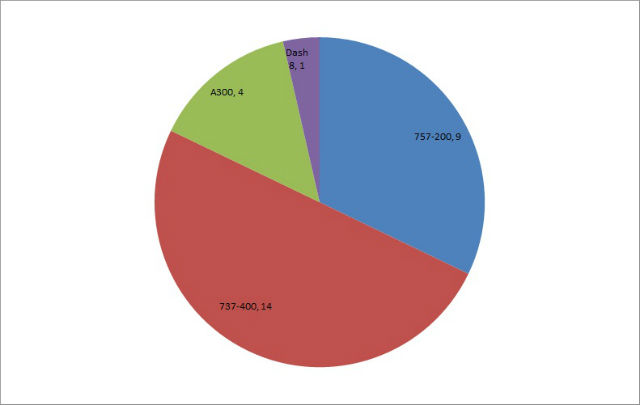The number of freighter conversions in the first six months of 2013 declined by 25%, with widebody and turboprop conversions showing particular weakness.
Overall, 28 passenger aircraft were converted to freighters in the six months to 30 June 2013, down from 37 a year earlier, Flightglobal's Ascend database shows. Conversions during the first six months have halved since the first half of 2008, when 57 commercial aircraft underwent conversion to freighters.
Analysts have attributed the decline of interest for dedicated freighters to the weak global economy and shippers' increasing use of surface transport. They also point to the 25t cargo capacity of the Boeing 777-300ER, which is double that of the Boeing 747-400, as being particularly detrimental to demand for long-haul widebody freighters.
Rob Morris, senior consultant at Flightglobal Ascend, says weak freight demand globally has caused the overall fleet of main deck freighters to fall by over 100 aircraft, or 7% of the total, since the end of 2007. This stems from airlines' efforts to better match capacity with demand.
"Passenger widebody fleets continue to grow and this delivers more belly hold capacity into the market," says Morris. "Thus, it seems airlines are not managing this reduction quickly enough as IATA's latest traffic numbers show year to date capacity growth ahead of traffic in all regions other than the Middle East. Capacity reduction inevitably results in the least efficient aircraft being removed from service first, and it is the passenger-to-freighter [P2F] aircraft that are suffering the most since they typically have worse payload-range and fuel burn performance than new builds."
Morris notes that the stored freighter fleet has grown by nearly 12% in the last two years. "Weak demand and relatively worse aircraft performance are the two key drivers behind the general reduction in demand for P2F conversions."
Conversions of widebody aircraft were particularly weak in the first half. In 2013, the only widebodies to undergo freighter conversion were four Airbus A300-600Rs owned by DHL unit European Air Transport (EAT). Three of the aircraft are operated by EAT, while the fourth is operated by Air Hong Kong.
Freighter conversions by type during first half of 2013

Flightglobal Ascend
Narrowbody conversions, however, were strong in the first half of 2013, with 23 versus 17 a year earlier. FedEx converted nine Boeing 757-200s to freighters, while a mix of other operators converted 14 Boeing 737-400s.
The average age of aircraft that were converted to freighters in the first half was 19.9 years, slightly younger than 20.4 years in the first half of 2012, Flightglobal's Ascend database shows. The average age of conversions in the first six months of 2008 was 19 years.
Ascend's Flightglobal Fleet Forecast predicts that over 200 new-build widebody freighters such as the A330-200, 767-300ERF, 747-8 and 777-200LRF will be delivered over the next five years.
"This delivery flow is expected to fulfil the majority of 'new' widebody demand that arises in that period and as a consequence we predict only around 70 widebody conversions in total through 2017," says Morris. "Longer-term, as more robust freight traffic demand is expected to return, passenger aircraft feedstock becomes available and passenger aircraft values for older aircraft reduce, widebody conversions are expected to recover to average around 36 annually through 2023."
Between 2018 and 2023, Ascend forecasts that 50% of new widebody freighter demand will be filled by new aircraft and the other 50% by P2Fs, with conversions of A330s, 767s, and 777-200ERs achieving "reasonable" conversion volumes in the coming 10 years.
Source: Air Transport Intelligence news
















